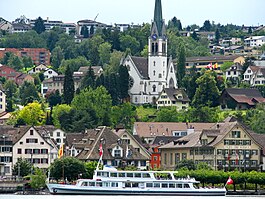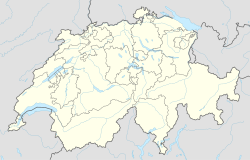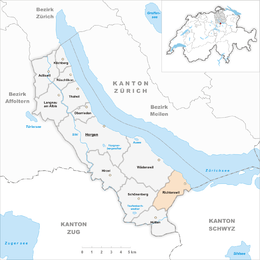Richterswil
| Richterswil | ||
|---|---|---|
 |
||
|
||
| Coordinates: 47°13′N 8°42′E / 47.217°N 8.700°ECoordinates: 47°13′N 8°42′E / 47.217°N 8.700°E | ||
| Country | Switzerland | |
| Canton | Zürich | |
| District | Horgen | |
| Area | ||
| • Total | 7.54 km2 (2.91 sq mi) | |
| Elevation | 408 m (1,339 ft) | |
| Population (Dec 2015) | ||
| • Total | 13,177 | |
| • Density | 1,700/km2 (4,500/sq mi) | |
| Postal code | 8805 | |
| SFOS number | 0138 | |
| Localities | Richterswil, Burghalden, Samstagern | |
| Surrounded by | Freienbach (SZ), Hütten, Männedorf, Schönenberg, Stäfa, Wädenswil, Wollerau (SZ) | |
| Website |
www SFSO statistics |
|
Richterswil (Swiss German: Richtischwiil ) is a municipality in the district of Horgen in the canton of Zürich in Switzerland.
Richterswil is first mentioned in 1265 as Richtliswile.
During the 17th Century, a series of peasant revolts broke out across Switzerland. One of these revolts, the 1645/46 Wädenswiler Steueraufstand (Wädenswil tax revolt), occurred around Lake Zürich and involved the village of Richterswil. The Richterswiler Weibel Rudolf Goldschmid was one of the leaders of the revolt who was executed in Zürich following the failure of the revolt. During the first Villmergen war (1656) Richterswil was invaded by an army from Schwyz. During the second Villmergen war, the newly built fortifications above the city, prevented another invasion. Under the French established Helvetic Republic Richterswil was part of the District of Horgen, and had a higher tax rate than surrounding villages. As part of this higher tax, during the War of the Second Coalition (1799), it was forced to house French troops. Following the unsuccessful uprising in 1804 (Bockenkrieg) against Zürich, Richterswil was punished severely.
From 1803-1831 it was part of the District of Wädenswil, but since 1831 has belonged to the District of Horgen. Since 1831, Samstagern has been part of the municipality Richterswil. In 1869 the majority of citizens of Richterswil voted against the new democratic cantonal constitution.
Richterswil has an area of 7.6 km2 (2.9 sq mi). Of this area, 54.7% is used for agricultural purposes, while 7.8% is forested. Of the rest of the land, 36.6% is settled (buildings or roads) and the remainder (0.9%) is non-productive (rivers, glaciers or mountains). In 1996[update] housing and buildings made up 26.4% of the total area, while transportation infrastructure made up the rest (10.2%). Of the total unproductive area, water (streams and lakes) made up 0.5% of the area. As of 2007[update] 34.8% of the total municipal area was undergoing some type of construction.
...
Wikipedia



